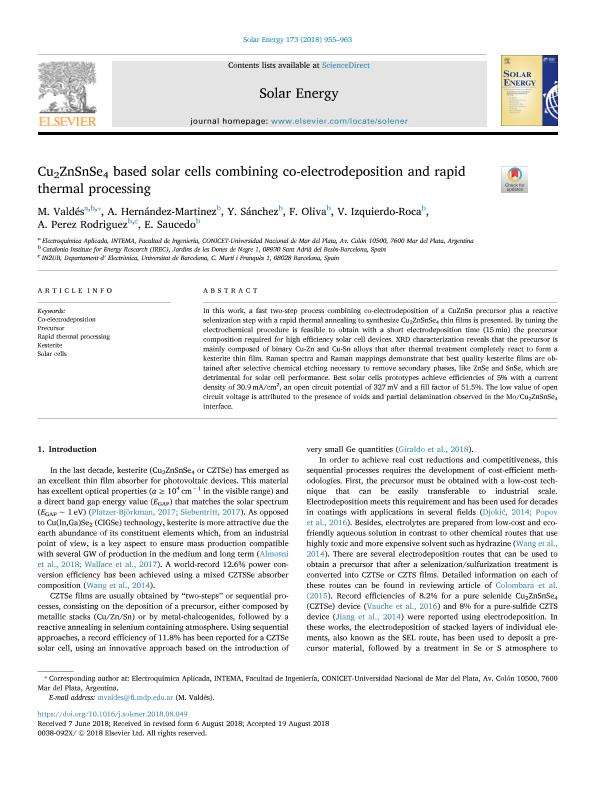Artículo
Cu2ZnSnSe4 based solar cells combining co-electrodeposition and rapid thermal processing
Valdes, Matias Hernan ; Hernández Martinez, A.; Sánchez, Y.; Oliva, F.; Izquierdo Roca, V.; Perez Rodriguez, A.; Saucedo, Edgardo
; Hernández Martinez, A.; Sánchez, Y.; Oliva, F.; Izquierdo Roca, V.; Perez Rodriguez, A.; Saucedo, Edgardo
 ; Hernández Martinez, A.; Sánchez, Y.; Oliva, F.; Izquierdo Roca, V.; Perez Rodriguez, A.; Saucedo, Edgardo
; Hernández Martinez, A.; Sánchez, Y.; Oliva, F.; Izquierdo Roca, V.; Perez Rodriguez, A.; Saucedo, Edgardo
Fecha de publicación:
10/2018
Editorial:
Pergamon-Elsevier Science Ltd
Revista:
Solar Energy
ISSN:
0038-092X
Idioma:
Inglés
Tipo de recurso:
Artículo publicado
Clasificación temática:
Resumen
In this work, a fast two-step process combining co-electrodeposition of a CuZnSn precursor plus a reactive selenization step with a rapid thermal annealing to synthesize Cu2ZnSnSe4 thin films is presented. By tuning the electrochemical procedure is feasible to obtain with a short electrodeposition time (15 min) the precursor composition required for high efficiency solar cell devices. XRD characterization reveals that the precursor is mainly composed of binary Cu-Zn and Cu-Sn alloys that after thermal treatment completely react to form a kesterite thin film. Raman spectra and Raman mappings demonstrate that best quality kesterite films are obtained after selective chemical etching necessary to remove secondary phases, like ZnSe and SnSe, which are detrimental for solar cell performance. Best solar cells prototypes achieve efficiencies of 5% with a current density of 30.9 mA/cm2, an open circuit potential of 327 mV and a fill factor of 51.5%. The low value of open circuit voltage is attributed to the presence of voids and partial delamination observed in the Mo/Cu2ZnSnSe4 interface.
Archivos asociados
Licencia
Identificadores
Colecciones
Articulos(INTEMA)
Articulos de INST.DE INV.EN CIENCIA Y TECNOL.MATERIALES (I)
Articulos de INST.DE INV.EN CIENCIA Y TECNOL.MATERIALES (I)
Citación
Valdes, Matias Hernan; Hernández Martinez, A.; Sánchez, Y.; Oliva, F.; Izquierdo Roca, V.; et al.; Cu2ZnSnSe4 based solar cells combining co-electrodeposition and rapid thermal processing; Pergamon-Elsevier Science Ltd; Solar Energy; 173; 10-2018; 955-963
Compartir
Altmétricas



